介绍
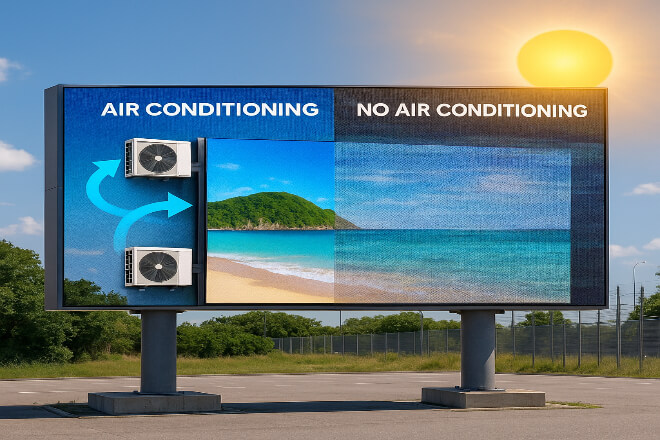
During the installation process of 户外LED屏幕, the question of whether air conditioning is necessary has always been a hotly debated topic.
Have you ever wondered: Do outdoor LED screens need air conditioning to cool them down during the scorching summer heat?
Is this just a marketing ploy, or is it truly necessary? Let’s delve deeper into this question.
目录
1. Why do many outdoor LED screens come with air conditioning?
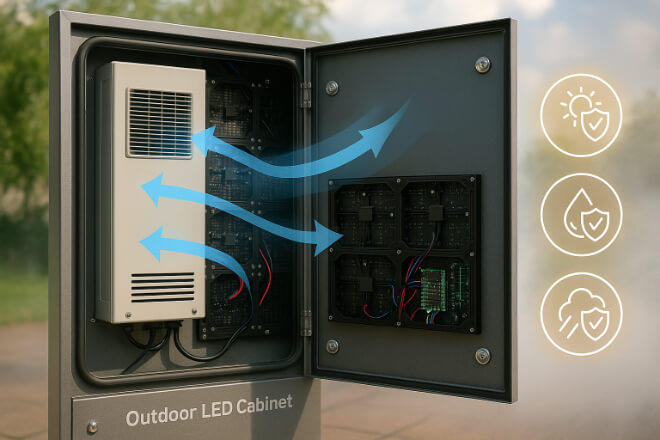
When many people first see 户外LED屏幕 with air conditioning, their initial reaction is: “How can LED screens be afraid of heat?” Well, they are.
In the summer, under the scorching sun, coupled with the heat generated by high-intensity operation.
The temperature inside the control box can soar to 60 or 70 degrees Celsius in a matter of minutes, hotter than a sauna. Relying solely on fans can only circulate the hot air but won’t cool it down at all.
Over time, the 电源, driver board, and control card can easily malfunction, resulting in either a drop in 亮度 or flickering screen artefacts, making maintenance a real expense.
Air conditioning not only reduces temperature but also solves several long-standing problems:
- Moisture-proofing:
During the rainy season or after a typhoon, the most common problem is the buildup of moisture inside the display.
Once the display “sweates,” the screen can suffer from flickering at best, or even a short circuit and become useless.
- Dust and salt spray protection:
In coastal areas or dusty areas, air conditioning maintains a slight positive pressure inside the display, making it less likely for dirt to enter.
- Stable image quality:
With a stable temperature, 亮度, and colour that won’t fluctuate from one morning to another, resulting in a comfortable and professional viewing experience.
This is especially true for displays in hot regions with full-time operation, facing 40°C sun during the day and running all-night advertising campaigns at night.
Without air conditioning, the display is essentially “heat-killed.” Air conditioning is like having an extra thermostat, preventing it from wearing out while running.
Simply put, the money spent on air conditioning isn’t wasted; it reduces screen malfunctions and downtime, and lasts longer. Don’t think the seller is trying to trick you into adding it; it’s a lifesaver.
2. Risks of not installing air conditioning on outdoor LED displays in hot regions
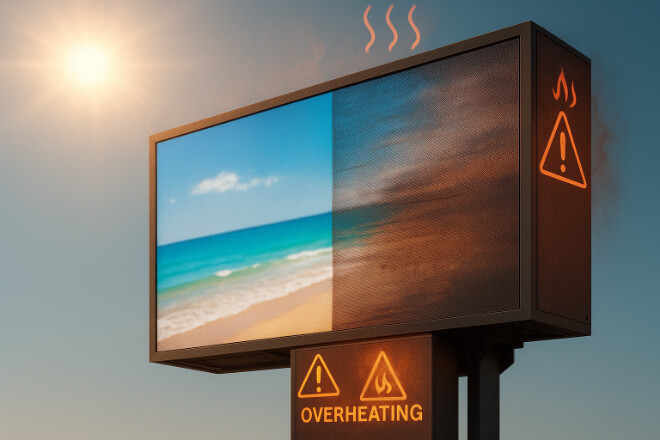
In the summer sun, the temperature of the cabinet skyrockets, especially during the afternoon and midday, when it can be several degrees hotter than outside.
The LED module is the most fragile component, and if overheated, it can malfunction—perhaps resulting in a black screen or even a distorted display.
For screens operating 24/7, this means advertising and promotional content could be interrupted at any time, missing crucial exposure time.
Core components like the control box, 电源, and driver board, operating at high temperatures are like being in a sauna.
Electrolytic capacitors and chips can’t withstand prolonged high temperatures and are prone to premature breakdown, shortening their lifespans.
Without air conditioning, maintenance is frequent, requiring replacement parts and downtime for repairs. The long-term costs are much higher than installing air conditioning.
High temperatures can cause screen brightness to drop and colours to shift, potentially tinting to yellow or bluish.
Advertisements and displays lose their sharpness, and once-attractive images can become dim and lacklustre, creating an unprofessional impression.
The aforementioned issues compound, resulting in a reduced overall screen lifespan and poor stability.
The screen is prone to malfunction, and 亮度 and colour are unstable, resulting in not only a poor user experience but also frequent downtime for repairs, which is both troublesome and expensive.
3. What are the "alternatives" to not installing air conditioning?
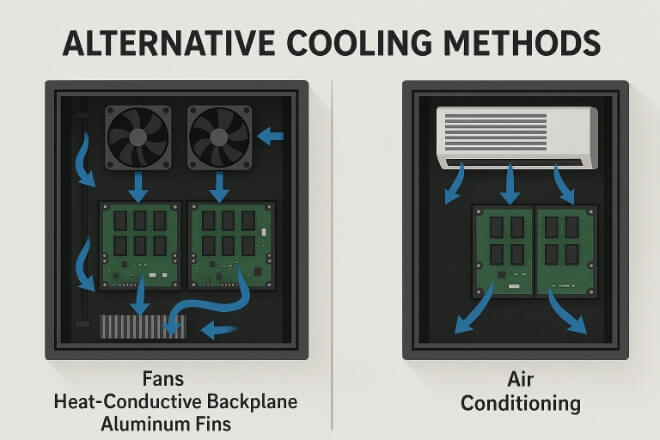
Some may ask, “Are there other ways to prevent outdoor LED screens from overheating without air conditioning?”
There are actually several compromise cooling solutions, but it’s important to note that each method has its pros and cons and is suitable for different scenarios.
1). High-power fan + heat exchange system
This is the most common alternative. It relies on powerful airflow to dissipate heat from the enclosure, preventing internal temperatures from accumulating too high.
It’s much more reliable than natural ventilation, as outdoor screens can’t rely solely on wind to cool them—wind can also bring in dust and rain, which is counterproductive.
However, fans will wear out over time and need regular inspection and replacement; otherwise, sudden failure could be troublesome.
2). Optimising the thermal conductive material of the module backplane
This addresses the problem at the source. Simply put, this allows the heat generated by the LED chips to be transferred to the outside of the enclosure more quickly, eliminating the need for airflow for cooling.
This method is quiet, energy-efficient, and rainproof. However, under direct sunlight or when operating continuously at high brightness.
The temperature control effect is limited, and the cooling effect is slightly less than that of air conditioning.
3). Use a passive cooling aluminum structure.
For example, a hollow enclosure or heat sink fins. This solution is durable, quiet, and dust- and rain-resistant.
However, in extreme heat, the enclosure will still slowly heat up, making it less stable than air conditioning.
In short, these alternatives are suitable for outdoor screens with low power consumption, low brightness, or occasional use, saving some investment and electricity costs.
However, if you’re operating in a hot climate, need 24/7 operation, or have a particularly important advertising space, air conditioning is the safest option—it reduces downtime, provides a stable image, and lasts a long time.
Adding this feature when purchasing a screen is truly worthwhile.
4. In what scenarios can you "safely omit air conditioning"?
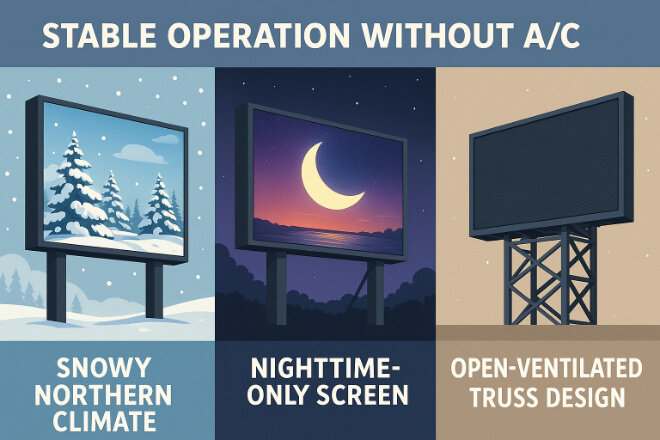
Some may ask, Do all outdoor LED screens require air conditioning? Actually, not all outdoor LED screens require air conditioning. There are several typical scenarios to consider:
- Northern climate + non-high-temperature seasons:
For example, in winter or spring and autumn, when temperatures are low, the internal temperature of the display cabinet doesn’t rise at all. In these situations, air conditioning is almost useless.
- The screen doesn’t run all day and all night:
For example, it’s only on at night and completely off during the day when exposed to the sun. This reduces heat accumulation and can eliminate the need for air conditioning.
After all, air conditioning is designed for prolonged high-temperature loads. If the screen has its own “rest time,” the internal components won’t be severely stressed.
- Open ventilation:
This means the display cabinet isn’t a completely enclosed truss structure, but rather has natural air circulation within the cabinet itself or in the installation environment. This airflow dissipates heat, making it much safer than a sealed environment.
Another key requirement is a high enough protection rating for the entire device, such as IP65 or higher.
The cabinet design includes appropriate heat dissipation channels or aluminium fins. Good passive cooling can also withstand high temperatures to a certain extent.
In short, in these situations, you might consider eliminating air conditioning, but the prerequisite is to understand the display’s operating environment, usage time, and protective design.
While eliminating air conditioning saves energy and money, safety comes first. Don’t waste your screen prematurely just to save a few bucks on electricity bills; it’s not worth the effort.
5. What factors should be considered when deciding whether to install air conditioning?
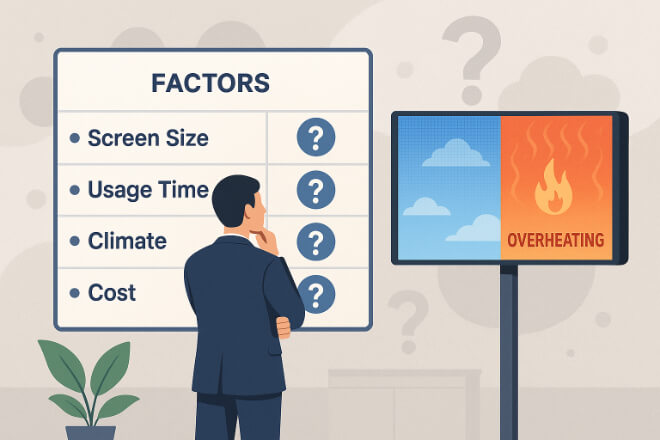
So, there’s no definitive answer to whether or not to install air conditioning on an outdoor LED screen. Several key factors need to be considered:
The larger the screen, the more heat is generated inside the enclosure.
A fully enclosed enclosure prevents heat from escaping, making it more prone to overheating.
Smaller screens or open enclosures don’t accumulate heat easily, placing less pressure.
The screen operates 24/7, especially during high temperatures and direct sunlight. Without air conditioning, the internal components are under immense strain.
Conversely, if the screen is only used at night or has a significant diurnal temperature swing, allowing it to “rest” during the day, air conditioning is less necessary.
The temperature in your area is also a key consideration. In areas where summer temperatures frequently exceed 40°C, air conditioning is almost essential.
In areas with more moderate temperatures and limited high temperatures, passive cooling or fan-assisted cooling can be considered.
Installing air conditioning will undoubtedly increase electricity bills.
But it can significantly reduce the frequency of problems such as component ageing, module failures, and colour deviations, thereby reducing repair and downtime costs.
In the long run, this investment is often much more cost-effective than frequent repairs.
In short, whether to install air conditioning depends on the screen’s design, usage environment, operating time, and climate, all weighed against your budget.
Saving money on electricity is easy, but making the wrong choice can lead to higher repair costs.
6. Conclusion
From the above analysis, we can see that whether an outdoor LED screen requires air conditioning depends on a variety of factors.In some cases, air conditioning is essential.
In other cases, other methods can address heat dissipation issues. We hope this article helps you make an informed decision.
Finally, if you would like to learn more about LED screens, please 联系我们.
